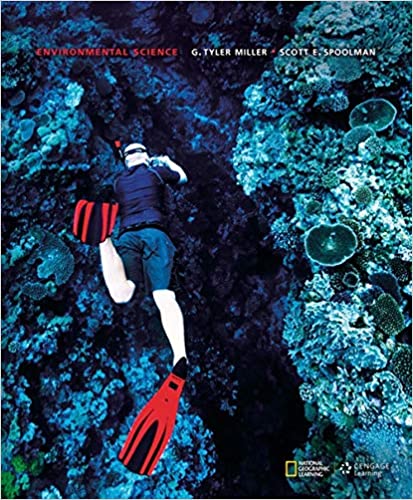
Environmental Science 15th Edition by Scott Spoolman,Tyler Miller
Edition 15ISBN: 978-1305090446
Environmental Science 15th Edition by Scott Spoolman,Tyler Miller
Edition 15ISBN: 978-1305090446 Exercise 16
BIOSPHERE 2-A LESSON IN HUMILITY
In 1991, eight scientists (four men and four women) were sealed inside Biosphere 2, a $200 million glass and steel enclosure designed to be a selfsustaining life-support system (Figure 17.A) that would increase our understanding of Biosphere 1-the earth's life-support system.
This sealed system of interconnected domes was built in the desert near Tucson, Arizona. It contained artificial ecosystems including a tropical rain forest, a savanna, a desert, a lake, streams, freshwater and saltwater wetlands, and a mini-ocean with a coral reef.
Biosphere 2 was designed to mimic the earth's natural chemical cycling systems. Water evaporated from its ocean and other aquatic systems and then condensed to provide rainfall over the tropical rain forest. The precipitation trickled through soil filters into the marshes and back into the mini-ocean before beginning the cycle again.
The facility was stocked with more than 4,000 species of plants and animals, including small primates, chickens, cats, and insects, selected to help maintain life-support functions. Human and animal excrement and other wastes were treated and recycled to help support plant growth. Sunlight and external natural gas-powered generators provided energy. The Biospherians were to be isolated for 2 years and to raise their own food using intensive organic agriculture. They were to breathe air recirculated by plants and to drink water cleansed by natural chemical recycling processes.
From the beginning, many unexpected problems cropped up and the life-support system began to unravel. The level of oxygen in the air declined with soil organisms converting it to carbon dioxide. Additional oxygen had to be pumped in from the outside to keep the Biospherians from suffocating.
Tropical birds died after the first freeze. An ant species got into the enclosure, proliferated, and killed off most of the system's original insect species. In total, 19 of the Biosphere's 25 small animal species became extinct. Before the 2-year period was over, all plant-pollinating insects became extinct, thereby dooming to extinction most of the plant species.
Despite many problems, the facility's waste and wastewater were recycled. With much hard work, the Biospherians were also able to produce 80% of their food supply. However, they suffered from persistent hunger and weight loss.
In the end, an expenditure of $200 million failed to maintain a life-support system for eight people for 2 years. Ecologists Joel Cohen and David Tilman, who evaluated the project, concluded, "No one yet knows how to engineer systems that provide humans with life-supporting services that natural ecosystems provide for free."
Critical Thinking
Some analysts argue that the problems with Biosphere 2 resulted mostly from inadequate design and that a better team of scientists and engineers could make it work. Explain why you agree or disagree with this view.

FIGURE 17.A Biosphere 2, constructed near Tucson, Arizona, was designed to be a self-sustaining life-support system.
PRNewsFoto/Huron Valley Travel/AP Images
In 1991, eight scientists (four men and four women) were sealed inside Biosphere 2, a $200 million glass and steel enclosure designed to be a selfsustaining life-support system (Figure 17.A) that would increase our understanding of Biosphere 1-the earth's life-support system.
This sealed system of interconnected domes was built in the desert near Tucson, Arizona. It contained artificial ecosystems including a tropical rain forest, a savanna, a desert, a lake, streams, freshwater and saltwater wetlands, and a mini-ocean with a coral reef.
Biosphere 2 was designed to mimic the earth's natural chemical cycling systems. Water evaporated from its ocean and other aquatic systems and then condensed to provide rainfall over the tropical rain forest. The precipitation trickled through soil filters into the marshes and back into the mini-ocean before beginning the cycle again.
The facility was stocked with more than 4,000 species of plants and animals, including small primates, chickens, cats, and insects, selected to help maintain life-support functions. Human and animal excrement and other wastes were treated and recycled to help support plant growth. Sunlight and external natural gas-powered generators provided energy. The Biospherians were to be isolated for 2 years and to raise their own food using intensive organic agriculture. They were to breathe air recirculated by plants and to drink water cleansed by natural chemical recycling processes.
From the beginning, many unexpected problems cropped up and the life-support system began to unravel. The level of oxygen in the air declined with soil organisms converting it to carbon dioxide. Additional oxygen had to be pumped in from the outside to keep the Biospherians from suffocating.
Tropical birds died after the first freeze. An ant species got into the enclosure, proliferated, and killed off most of the system's original insect species. In total, 19 of the Biosphere's 25 small animal species became extinct. Before the 2-year period was over, all plant-pollinating insects became extinct, thereby dooming to extinction most of the plant species.
Despite many problems, the facility's waste and wastewater were recycled. With much hard work, the Biospherians were also able to produce 80% of their food supply. However, they suffered from persistent hunger and weight loss.
In the end, an expenditure of $200 million failed to maintain a life-support system for eight people for 2 years. Ecologists Joel Cohen and David Tilman, who evaluated the project, concluded, "No one yet knows how to engineer systems that provide humans with life-supporting services that natural ecosystems provide for free."
Critical Thinking
Some analysts argue that the problems with Biosphere 2 resulted mostly from inadequate design and that a better team of scientists and engineers could make it work. Explain why you agree or disagree with this view.

FIGURE 17.A Biosphere 2, constructed near Tucson, Arizona, was designed to be a self-sustaining life-support system.
PRNewsFoto/Huron Valley Travel/AP Images
Explanation
Biosphere-2 was designed on the principl...
Environmental Science 15th Edition by Scott Spoolman,Tyler Miller
Why don’t you like this exercise?
Other Minimum 8 character and maximum 255 character
Character 255


